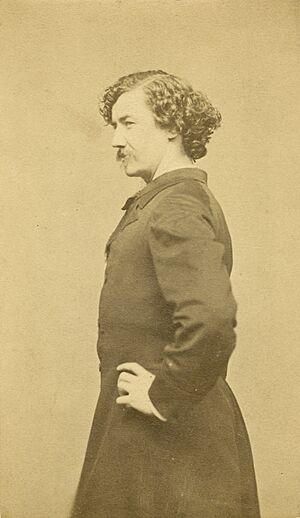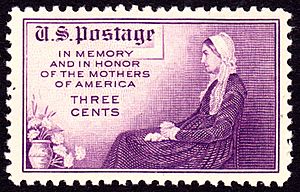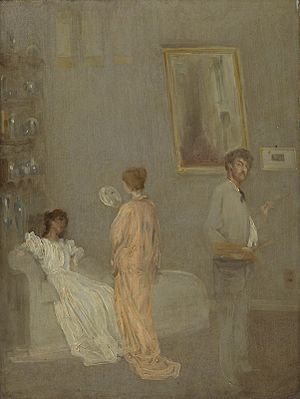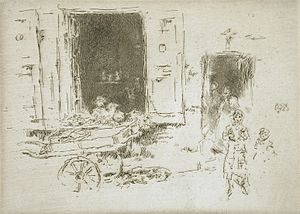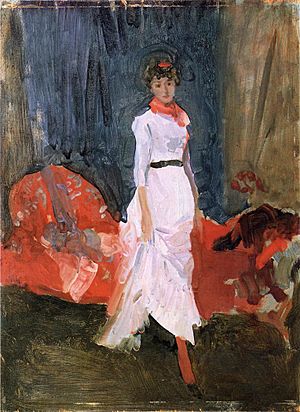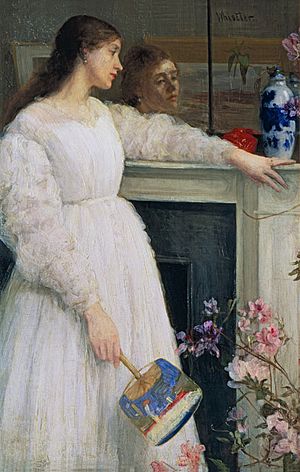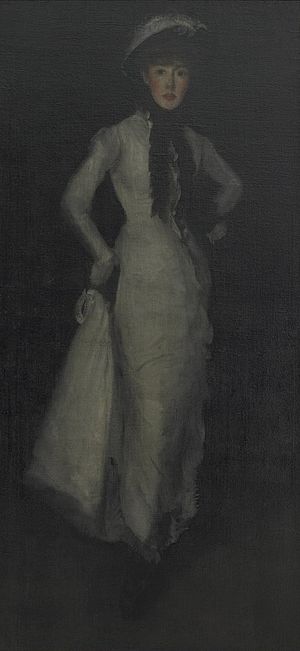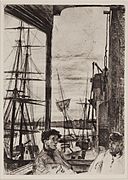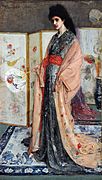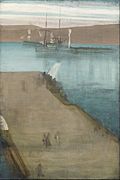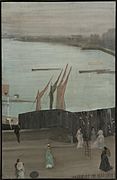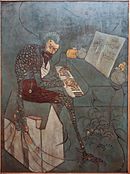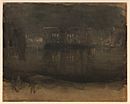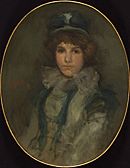James McNeill Whistler facts for kids
Quick facts for kids
James McNeill Whistler
|
|
|---|---|
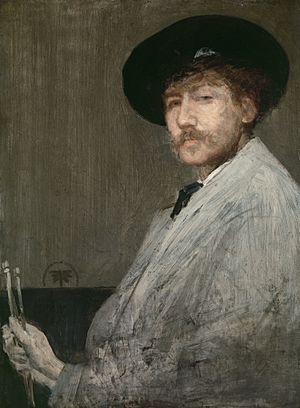
Arrangement in Gray: Portrait of the Painter
(self portrait, c. 1872), Detroit Institute of Arts |
|
| Born | July 10, 1834 |
| Died | July 17, 1903 (aged 69) London, England, UK
|
| Nationality | American |
| Education | United States Military Academy, West Point, New York |
| Known for | Painting |
|
Notable work
|
Whistler's Mother |
| Movement | Founder of Tonalism |
| Spouse(s) | |
| Awards |
|
James Abbott McNeill Whistler (July 10, 1834 – July 17, 1903) was an American painter and printmaker. He worked mainly in the United Kingdom during a time known as the American Gilded Age. Whistler believed in "art for art's sake", meaning art should be appreciated for its beauty, not for a story or a moral message.
He used a special butterfly symbol as his signature on paintings. This symbol had a long stinger, showing both his delicate art style and his strong, sometimes argumentative, personality. Whistler thought painting was like music. He named many of his artworks "arrangements", "harmonies", and "nocturnes". This showed how important color and tone were to him. His most famous painting is Arrangement in Grey and Black No. 1 (1871), often called Whistler's Mother. It's a well-known portrait of motherhood that has been copied and parodied many times. Whistler's ideas about art and his friendships with other artists greatly influenced the art world.
Contents
Early Life and Art Beginnings
Family Background
James Abbott Whistler was born in Lowell, Massachusetts, on July 10, 1834. He was the first child of Anna McNeill Whistler and George Washington Whistler. His younger brother was William McNeill Whistler.
Whistler later used his mother's maiden name, McNeill, as an extra middle name after she passed away.
Childhood in New England
His father was a railroad engineer. James spent his first three years in a house in Lowell, Massachusetts. This house is now the Whistler House Museum of Art, a museum dedicated to him. Whistler was a moody child and sometimes lazy, especially when he was ill. His parents found that drawing helped him calm down and focus.
In 1837, his family moved to Stonington, Connecticut. His father worked for the Stonington Railroad. In 1839, his father became chief engineer for the Boston and Albany Railroad. The family then built a large house in Springfield, Massachusetts. They lived there until they moved to Russia in late 1842.
Time in Russia and England
In 1842, Nicholas I of Russia hired Whistler's father to design a railroad. The family moved to St. Petersburg to join him. Young Whistler took private art lessons there. At age eleven, he joined the Imperial Academy of Arts. He learned traditional drawing from plaster casts and live models. He enjoyed talking about art with older students. In 1844, he met the artist Sir William Allan. Allan told Whistler's mother, "Your little boy has uncommon genius."
From 1847 to 1848, his family stayed in London with relatives. His brother-in-law, Francis Seymour Haden, who was a doctor and artist, encouraged Whistler's interest in art and photography. Haden took Whistler to art lectures and gave him a watercolor set. Whistler began to dream of an art career. He collected art books and studied different artists' techniques. At fifteen, he wrote to his father, hoping he wouldn't object to his choice. Sadly, his father died from cholera at 49. The family then moved back to his mother's hometown in Pomfret, Connecticut.
Studying at West Point
Whistler first went to Christ Church Hall School. His mother hoped he would become a minister. But Whistler always had his sketchbook and was popular for his caricatures. It became clear that a religious career was not for him. So, he applied to the United States Military Academy at West Point, where his father had taught. He was accepted in July 1851.
During his three years there, his grades were not very good. He often broke rules and made sarcastic comments. Colonel Robert E Lee, the superintendent, eventually had to dismiss him. Whistler's main achievement at West Point was learning drawing and map making from artist Robert W. Weir. He left after failing a chemistry exam. He famously said, "If silicon were a gas, I would have been a general one day."
First Job and Moving to Paris
After West Point, Whistler worked as a draftsman. He mapped the U.S. coast for military and sea purposes. He found the work boring and was often late or absent. He spent his free time playing billiards and was always short on money. When his drawings of sea creatures appeared on the maps, he was moved to the etching department. He only stayed two months, but he learned the etching technique, which helped his art career later.
At this point, Whistler decided art was his future. He lived in Baltimore for a few months with a wealthy friend, Tom Winans. Winans gave him a studio and some money. Whistler made important contacts in the art world and sold some early paintings to Winans. He turned down his mother's ideas for other jobs. He told her he was going to Paris to study art. Whistler never returned to the United States.
Art Studies in France
Whistler arrived in Paris in 1855. He rented a studio in the Latin Quarter and quickly became a bohemian artist. He studied traditional art methods for a short time at the Ecole Impériale and with Charles Gleyre. Gleyre taught him two key ideas: that lines are more important than color, and that black is the main color for tonal harmony. Whistler preferred to study on his own and enjoy the café life.
He spent money freely and was often in debt. To save money, he copied and sold works from the Louvre museum. He also moved to cheaper places. In 1858, Whistler traveled through France and the Rhineland with artist Ernest Delannoy. He created a group of etchings called "The French Set." That year, he painted his first self-portrait, Portrait of Whistler with Hat. It looked like the work of Rembrandt. Most importantly, he became friends with Henri Fantin-Latour at the Louvre. Through him, Whistler met artists like Gustave Courbet, Édouard Manet, and Charles Baudelaire. Baudelaire's ideas influenced Whistler to show real life in his art, not just old myths.
Moving to London
Whistler painted his first exhibited work, La Mère Gérard, in 1858. He then painted At the Piano in 1859 in London, which became his home. He still visited friends in France often. At the Piano showed his niece and her mother in their music room. Critics praised his "genuine feeling for colour and a splendid power of composition." The painting was simple and contrasted the mother in black with the daughter in white. It was shown at the Royal Academy the next year.
He painted another scene in the same room, called Harmony in Green and Rose: The Music Room. This showed his desire to try new things in art. It also showed his way of working: a quick start, big changes, a break, and then a final rush to finish. In 1860, he made a set of etchings called Thames Set. He also created early impressionistic works like The Thames in Ice. He was starting to develop his style of tonal harmony using a limited color palette.
Early Career Highlights
In 1861, Whistler painted his first famous work, Symphony in White, No. 1: The White Girl. It was a portrait of his model, Joanna Hiffernan. He wanted it to be a study in white colors. However, others saw different meanings. Some thought it was about a bride losing her innocence. In England, some saw it as a Pre-Raphaelite painting. The conservative Royal Academy refused to show it. But it was displayed in a private gallery as The Woman in White. In 1863, it was shown at the Salon des Refusés in Paris. This was an event for artworks rejected by the main art show.
Whistler's painting got a lot of attention. His supporters said it was "an apparition with a spiritual content." They said it showed his idea that art should focus on arranging colors in harmony, not just copying nature. Two years later, Whistler painted another portrait of Hiffernan in white. This one, The Little White Girl, showed his new interest in Asian art. His paintings Lady of the Land Lijsen and The Golden Screen (1864) also showed his model in Asian clothes and settings.
In January 1864, Whistler's very religious mother arrived in London. This changed his bohemian lifestyle. He wrote to a friend, "General upheaval!! I had to empty my house and purify it." He moved his model, Joanna Hiffernan, to another place. From 1866, Whistler lived in Chelsea, London, an area popular with artists.
Later Career and Famous Works
Nocturnes: Painting Music
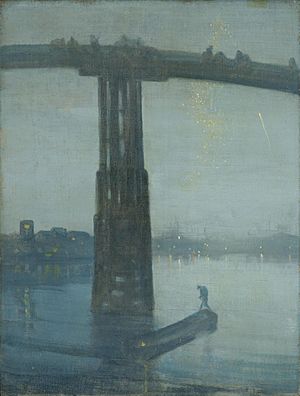
In 1866, Whistler visited Valparaíso, Chile. This trip led to his first three "nocturnal" paintings. These were night scenes of the harbor, painted with blue or light green colors. After returning to London, he painted more nocturnes over the next ten years. Many showed the River Thames and Cremorne Gardens, a park known for fireworks. The fireworks were a new challenge to paint. In his sea nocturnes, Whistler used thin paint and light touches of color to suggest ships, lights, and shorelines. Some of his Thames paintings also looked like Japanese prints by Hiroshige.
In 1872, Whistler said his patron, Frederick Richards Leyland, inspired his musical titles. Leyland was an amateur musician who loved Chopin. Whistler then painted a self-portrait called Arrangement in Gray: Portrait of the Painter (c. 1872). He also started renaming his older works with musical terms like "nocturne", "symphony", or "arrangement". This showed that the mood and colors were more important than the story in the painting. Whistler's nocturnes were very new and different.
Famous Portraits
The Franco-Prussian War of 1870 caused many French artists to move to England, including Camille Pissarro and Claude Monet. Whistler was moving away from the "realism" style of Courbet.
Whistler's Mother
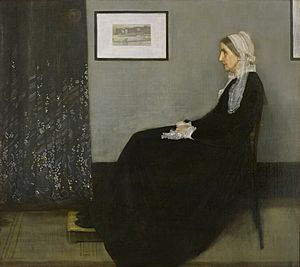
By 1871, Whistler returned to painting portraits. He soon created his most famous work, Arrangement in Grey and Black No.1, known as Whistler's Mother. One day, a model didn't show up. So, Whistler asked his mother to pose. She first stood, but it was too tiring, so she sat down. It took many sittings to finish the painting.
This simple portrait uses a limited color palette. It's another example of Whistler's focus on tonal harmony and balance. The design looks simple, but it carefully balances the shapes of the curtain, picture, and floor with the curves of her face, dress, and chair. Whistler said the painting's story wasn't important. But it also honored his mother. She helped him by making his home life more stable and attracting art buyers.
The public didn't like the painting at first. They thought its simplicity was too different from the popular sentimental and fancy art of the time. Critics called it a failed "experiment." The Royal Academy rejected it, but later accepted it after some persuasion. They hung it in a bad spot at their exhibition.
From the start, Whistler's Mother caused many reactions, from jokes to deep respect. It has been parodied in cards and cartoons. Whistler helped make the painting famous by showing it often and allowing copies to be made. The painting was almost destroyed in a train fire once. The French government eventually bought it. It was the first of Whistler's works to be in a public collection. It is now in the Musée d'Orsay in Paris.
During the Great Depression in the United States, the painting was called a "million dollar" artwork. It was a big hit at the 1933–34 Chicago World's Fair. People around the world saw it as a symbol of motherhood. In 1934, the United States even put the painting on a postage stamp.
Other Portraits
Other important portraits by Whistler include those of Thomas Carlyle (a historian, 1873), Maud Franklin (his model, 1876), and Théodore Duret (a critic, 1884). In the 1870s, he painted full-length portraits of his supporter Frederick Leyland and his wife. Leyland then asked Whistler to decorate his dining room.
Whistler was often upset that his paintings were not accepted or hung well at the Royal Academy. So, in 1874, he held his first solo show. The show was special because Whistler designed and decorated the hall himself. The decorations matched his paintings, following his art ideas. A reviewer wrote that visitors felt a "curious sense of harmony" in the gallery.
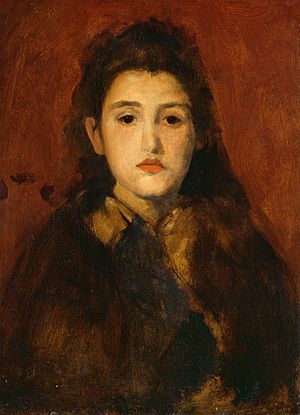
Whistler was not as successful as other portrait painters like John Singer Sargent. This might be because his style was simple, he didn't flatter his subjects, and he was known for being difficult. He also worked very slowly and needed very long sittings. By the 1890s, when he became more accepted, he was past his best as a portrait painter.
Printmaking Skills
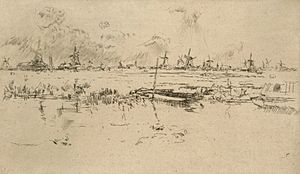
Whistler created many etchings, lithographs, and dry-points. His lithographs were about half as many as his etchings. Some showed figures, others were of the River Thames, and some showed parts of Paris and London.
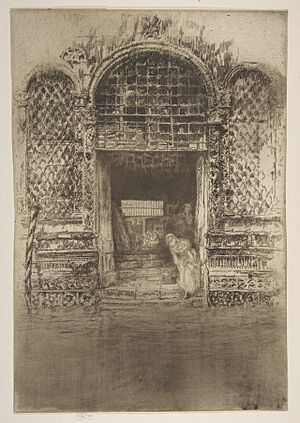
His etchings included portraits of family, models, and street scenes in London and Venice. Whistler became very famous as an etcher. One expert, Martin Hardie, even compared him to Rembrandt. Whistler was very careful about how he printed his etchings and chose the paper.
Butterfly Signature and Art Settings
Whistler's famous butterfly signature started in the 1860s. He was interested in Asian art and the marks on china. He decided to create a monogram of his initials. Over time, it became an abstract butterfly shape. Around 1880, he added a stinger to the butterfly. This showed both his gentle artistic side and his strong, feisty personality. He carefully placed this signature on his paintings and custom frames. His focus on balance and harmony went beyond the frame. He also thought about how his paintings fit into a room, and even designed whole rooms, like the Peacock Room.
The Peacock Room
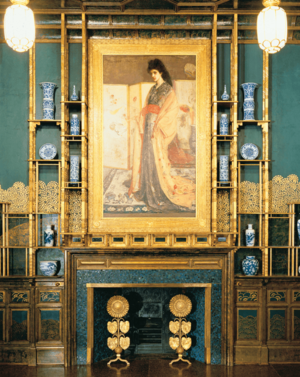
Harmony in Blue and Gold: The Peacock Room is Whistler's most famous interior decoration. He painted it in 1876–1877. It is a great example of the Anglo-Japanese style. Frederick Leyland, the owner, asked Whistler to make small changes to the room. Its main purpose was to display Leyland's china collection. Whistler painted over the original room design in bright blue-greens with gold.
Whistler let his imagination take over. He said, "I just painted on. I went on—without design or sketch—putting in every touch with such freedom." He completely painted over expensive 16th-century leather wall coverings.
Later, an American businessman named Charles Lang Freer bought the entire room in 1904. This included Whistler's painting The Princess from the Land of Porcelain, which was the centerpiece. Freer had the Peacock Room moved to his mansion in Detroit. After Freer's death in 1919, the room was permanently installed in the Freer Gallery of Art at the Smithsonian in Washington, D.C. The gallery opened in 1923. Whistler also painted a funny picture of Leyland as a peacock playing a piano. It was called The Gold Scab: Eruption in Frilthy Lucre.
Ruskin Trial
In 1877, Whistler sued the art critic John Ruskin. Ruskin had strongly criticized Whistler's painting Nocturne in Black and Gold: The Falling Rocket. Whistler had shown this painting at the Grosvenor Gallery. Ruskin wrote in his publication, Fors Clavigera, that the painting was like "flinging a pot of paint in the public's face."
Whistler was very angry. He sued Ruskin for libel (writing something false and damaging). Whistler hoped to win £1,000. The trial happened in 1878. Many artists were afraid to support Whistler as witnesses. The jury did not like Whistler's painting. Even though Ruskin's witnesses were more impressive, the jury decided in favor of Whistler. However, they only awarded him a tiny amount of money, a farthing. The cost of the trial, plus debts from building his house, made Whistler go bankrupt in May 1879. His art and house were sold at auction.
Whistler published his side of the trial in a pamphlet. He hoped the trial would help his career, but he lost popularity instead. He always blamed Leyland, his former patron, for his financial problems.
Later Years and Legacy
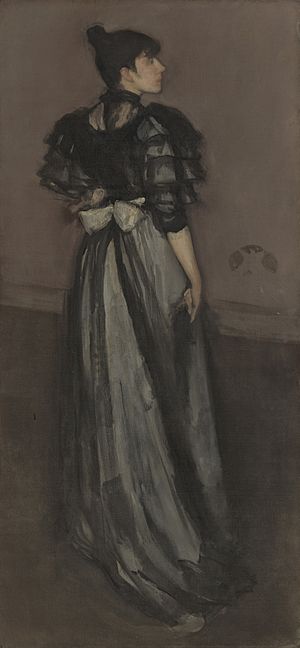
After the trial, Whistler got a job to make twelve etchings in Venice. He went there with his model, Maud Franklin. He worked hard to discover the city's unique character. He finished over fifty etchings, several nocturnes, watercolors, and over 100 pastels. These showed Venice's moods and architecture. Whistler also influenced American artists in Venice, who later spread his methods in America.
Back in London, his pastels sold well. He was still struggling financially but felt encouraged by the attention from younger artists. They looked up to him and called themselves "pupil of Whistler." Many of them returned to America and shared stories of Whistler's wit and art ideas.
In 1885, Whistler published his first book, Ten O'Clock lecture. In it, he explained his belief in "art for art's sake". He said art was its own purpose. The artist's job was to interpret what he saw, not to copy nature exactly or teach a moral lesson. He famously said, "Nature is very rarely right."
In January 1881, his mother, Anna Whistler, died. In her honor, he publicly added her maiden name, McNeill, as his middle name.
Whistler joined the Society of British Artists in 1884. He became president in 1886. He helped the Society become "Royal" by presenting an album to Queen Victoria during her Golden Jubilee. However, he soon had disagreements with the Royal Academy of Arts. He was voted out of the Society in 1888.
His relationship with Maud Franklin ended. Whistler then proposed to Beatrice Godwin, a former student and the widow of his friend, architect Edward William Godwin. They married on August 11, 1888. Whistler's reputation in London and Paris grew, and he received good reviews and new art jobs. His book The Gentle Art of Making Enemies was published in 1890.
In 1890, he met Charles Lang Freer, who became a very important art collector for him in America. In 1891, with help from his friend Stéphane Mallarmé, Whistler's Mother was bought by the French government.
After a mixed reception for his solo show in London, Whistler decided to leave. He and Beatrice moved to Paris in 1892. He felt welcomed by old friends like Monet and Auguste Rodin. He was at the peak of his career when his wife, Beatrice, was diagnosed with cancer. They returned to London in 1896 for medical treatment. He drew scenes of the River Thames from their hotel window as he sat with her. She died a few months later. Her death was a great sadness for Whistler.
In 1899, Charles Freer introduced Whistler to businessman Richard Albert Canfield. Canfield became a personal friend and patron. He owned a large collection of Whistler's art. In 1901, Canfield asked Whistler to paint his portrait. Whistler was ill and weak at this time. This portrait was his last completed one.
In his last seven years, Whistler painted some simple seascapes in watercolor and a final self-portrait in oil. He started an art school in 1898, but it closed in 1901 due to his poor health. He died in London on July 17, 1903, at age 69. He is buried in Chiswick Old Cemetery in west London.
His friends, Joseph and Elizabeth Robins Pennell, wrote a biography about him in 1908. Whistler's art collection was left to his sister-in-law, Rosalind Birnie Philip. She spent her life protecting his reputation and managing his art, much of which went to Glasgow University.
Personal Relationships
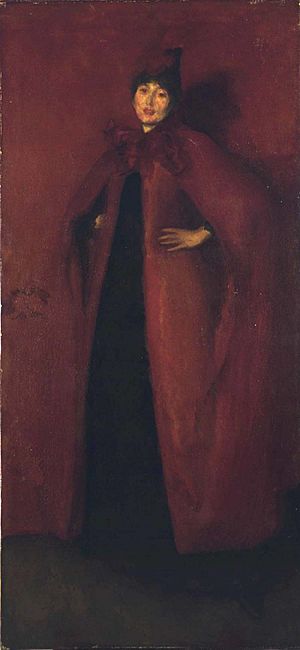
Whistler had a unique look: short and thin, with sharp eyes and a curly mustache. He often wore a monocle and fancy clothes. He acted confident and unusual. He could be arrogant with friends and art buyers. He loved to promote himself and shock people. While he could be funny about social issues, he was always serious about art. He often started public arguments to defend his strong art theories.
Whistler had a high-pitched, slow voice with planned pauses. A friend said he wasn't just talking; he was "sketching in words." He was known for his sharp wit, especially with his friend and rival Oscar Wilde. They were both famous in Paris social circles and often appeared in funny cartoons in Punch magazine. Once, Oscar Wilde said, "I wish I'd said that" after Whistler made a brilliant remark. Whistler replied, "You will, Oscar, you will!" Wilde often repeated Whistler's witty sayings. Their friendship ended in the mid-1880s.
Whistler was friends with many French artists, including Henri Fantin-Latour and Gustave Courbet. He also knew Édouard Manet and the Impressionists, like Claude Monet and Edgar Degas. As a young artist, he was close friends with Dante Gabriel Rossetti. His friendships with Monet and poet Stéphane Mallarmé helped increase respect for Whistler in France.
His model for The White Girl, Joanna Hiffernan, also posed for Gustave Courbet. During the 1870s and 1880s, he lived with his model, Maud Franklin. She was able to sit still for long periods, which helped Whistler improve his portrait skills. He painted several excellent portraits of her.
In 1888, Whistler married Beatrice Godwin, also called Trixie. She was the widow of his friend E. W. Godwin, the architect who designed Whistler's White House. Beatrice and her sisters posed for many of Whistler's paintings. The first five years of their marriage were very happy. But then Beatrice became ill with cancer and eventually died. Her death was a strong blow to Whistler.
Legacy and Influence
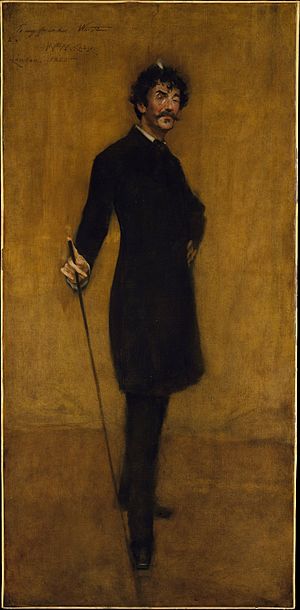
Whistler was inspired by artists like Rembrandt and Velázquez. He used these influences to create his own unique and important style. He was skilled in many art forms, including over 500 paintings, etchings, pastels, watercolors, drawings, and lithographs. Whistler was a leader in the Aesthetic Movement. He promoted the "art for art's sake" idea through his writings and lectures. He taught his students to use simple designs, avoid overworking their art, and focus on the harmony of colors.
Whistler has been the subject of many major museum shows and studies. Like the Impressionists, he used nature as a source for his art. Whistler believed it was the artist's job to interpret what they saw, not just copy reality. He said artists should "bring forth from chaos glorious harmony."
During his life, he influenced two generations of artists in Europe and the United States. He shared ideas with Realist, Impressionist, and Symbolist painters. Artist Walter Sickert was his student, and writer Oscar Wilde was his friend. His style, called Tonalism, greatly influenced many American artists.
During his fourteen-month stay in Venice in 1879 and 1880, Whistler created many etchings and pastels. This helped his finances after he went bankrupt. It also changed how artists and photographers saw Venice. He focused on the city's back alleys, small canals, and architectural details, capturing its unique atmosphere.

Honored on Issue of 1940
In 1940, Whistler was honored on a United States postage stamp. This was part of the "Famous Americans Series" that celebrated important Americans.
The Gilbert and Sullivan operetta Patience made fun of the Aesthetic movement. The character Reginald Bunthorne is often seen as a parody of Oscar Wilde, but he also has traits of Whistler.
Novelist Henry James based several characters on Whistler in his books, like Roderick Hudson and The Tragic Muse. Whistler was also the model for the painter Elstir in Marcel Proust's novel, In Search of Lost Time.
The house where Whistler was born in Lowell, Massachusetts, is now the Whistler House Museum of Art. He is buried at St Nicholas Church, Chiswick.
Honors and Recognition
Whistler received worldwide recognition during his lifetime:
- 1884: Became an honorary member of the Royal Academy of Fine Arts in Munich.
- 1892: Made an officer of the Légion d'honneur in France.
- 1898: Became a founding member and first president of the International Society of Sculptors, Painters and Gravers.
A statue of James McNeill Whistler was put up in 2005. It is by Nicholas Dimbleby and stands at the north end of Battersea Bridge on the River Thames in the United Kingdom.
Gallery
Auction Records
On October 27, 2010, Swann Galleries set a record price for a Whistler print at auction. His etching and drypoint Nocturne (1879–80) sold for $282,000.
See also
 In Spanish: James McNeill Whistler para niños
In Spanish: James McNeill Whistler para niños
- John Wharlton Bunney
- Western painting





